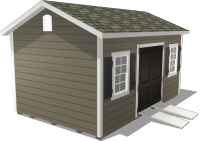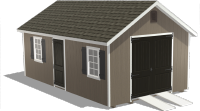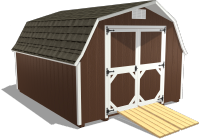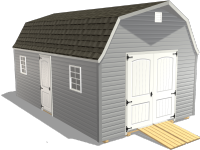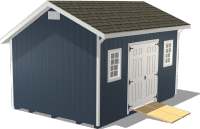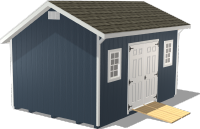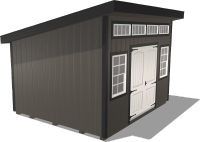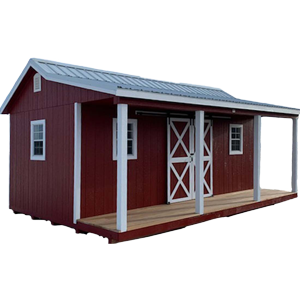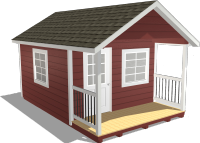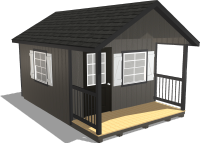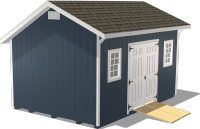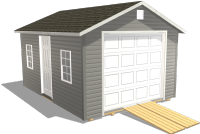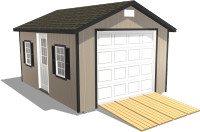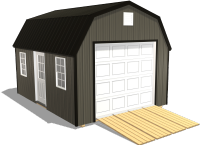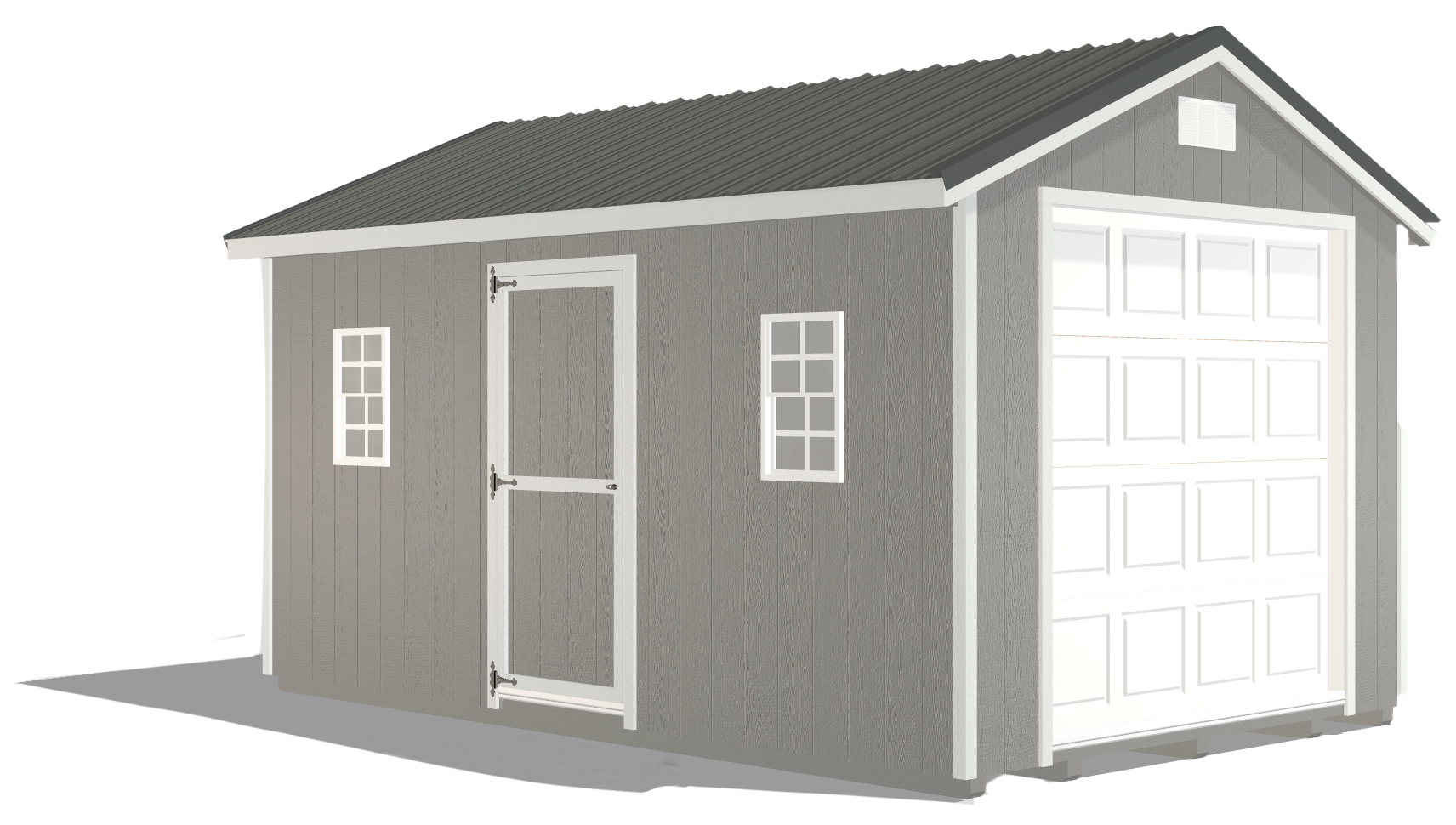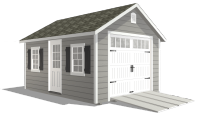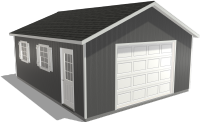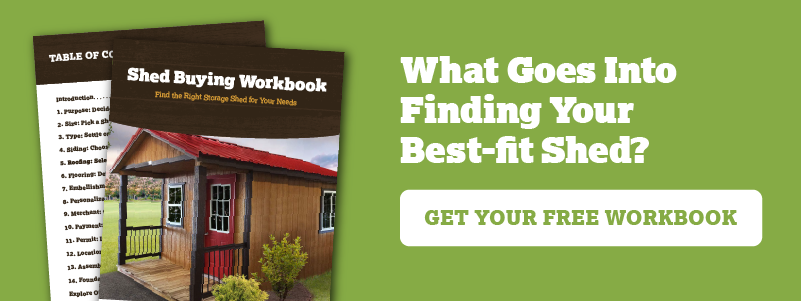Buy a Shed With Confidence: 6 Things to Consider First
by Dakota Storage Buildings, on May 12, 2025
Buying a shed is a big decision, and it’s important to get it right. With so many options available, it can be overwhelming to determine which one best fits your needs.
There’s more to picking the perfect shed than just choosing a style. You’ll also need to think about zoning rules, where it’ll go in your yard, how much does a shed cost, and what materials will hold up best over time.
Without the right guidance, you risk making costly mistakes, like purchasing a shed that doesn’t comply with local permits, selecting materials that deteriorate too quickly, or underestimating storage space needs. That’s why we’ve created this guide — to walk you through the essential steps of buying a shed with confidence.
In this blog, we’ll cover key factors like permits, placement, pricing, and material choices so you can make an informed decision and invest in a shed that lasts.
Do I Have to Get a Building Permit?
Always check to see what zoning codes apply to your area. Rural areas are usually more flexible. However, for people who live in cities, towns, or subdivisions, there may be restrictions on size, color, and sometimes even style that have to be approved by a council or business official before ordering.

In many places, any building bigger than a small garden shed will require a permit, so it's necessary to check with the local government or your subdivision board.
We understand that pulling permits and checking into zoning is something that you would typically never have to do unless you are a contractor or builder. So we've pulled this information to help you with the process and make it less complicated.
3 Common Permit Mistakes to Avoid
- Forgetting to check with the local zoning office before purchasing a shed.
- Misunderstanding size limits for permit exemptions.
- Overlooking HOA restrictions on materials, colors, or placement.
What Do I Need to Know About Shed Placement?
Once you obtain your permit, be sure to read it thoroughly as there may be unexpected building limitations listed, and you don't want to miss them.
Limitations can include how far a shed should be placed from property lines, how far away a shed should be from a residential building, color restrictions, and potential placement stipulations.
Ideas for Shed Placement
Permit restrictions aside, to pinpoint the best location for a backyard shed on your property, consider how you'll be using it.
For instance, if it's being used primarily as a garden shed, keep it close to the garden and a water source. If you plan to store a lawn mower in your shed, make sure the doors can open fully, the ramp can be extended entirely, and the mower can maneuver in and out without restriction.
If you’re turning your shed into a remote workspace, placing it closer to your home or patio can make it easier to access while still offering a quiet retreat. For those who love entertaining, a shed near an outdoor gathering space — like a firepit or kitchen — is a smart move.

✔️ Accessibility: Ensure easy access for frequent use, including wide pathways for lawnmowers and wheelbarrows.
✔️ Sunlight and Shade: Position your shed to receive adequate sunlight for gardening sheds or workspaces while avoiding excessive shade that can cause mold and moss buildup.
✔️ Distance from the Main House: Close enough for convenience but far enough to avoid visual clutter or excessive noise.
✔️ Ground Conditions: Select a stable, well-drained area to prevent foundation issues. Avoid low-lying spots prone to pooling water.
✔️ Future Landscaping Plans: Consider how the shed placement aligns with any future garden expansions, pool installations, or outdoor projects.
✔️ Security Considerations: Placing your shed within view of your home can improve security. If storing valuable equipment, consider adding locks or motion-activated lighting.
Is It Cheaper to Build a Shed or Buy a Shed?
One of the most common shed-buying questions is “How much does a shed cost?” Is it more cost-effective to build a shed from scratch or purchase a pre-built model? Each option has its pros and cons depending on your budget, skills, and long-term storage needs.
Build Your Own Shed (DIY)
DIY shed kits typically range from $1,500 to $4,000, depending on the size, complexity, and materials. These kits provide a cost-effective way to build a shed, but they require construction skills, the right tools, and significant time investment. Some kits come with pre-cut lumber and detailed instructions, while others may require additional cutting and modifications.
If you have carpentry experience, building a shed from scratch allows you to completely customize the materials, design, and layout. However, if you're new to construction, the risk of mistakes — like improper framing or inadequate foundation preparation — can lead to structural issues down the line.
Additionally, factoring in the cost of tools, hardware, and unexpected materials can make DIY sheds more expensive than initially anticipated.
Pros:
- Lower upfront costs for basic designs compared to prefab or custom sheds.
- Fully customizable: you can select materials, size, and design features to suit your exact needs.
- Sense of accomplishment from completing a DIY project and gaining hands-on experience.
Cons:
- Requires carpentry skills: cutting, framing, and roofing experience is necessary for a structurally sound shed.
- Time-consuming: assembly, cutting, and securing permits can take several weekends to complete.
- Potential for costly mistakes: errors in design, materials, or assembly can lead to extra costs and structural issues.
- Hidden costs: tools, nails, screws, paint, and other materials can add up, making it more expensive than anticipated.
Buy a Pre-Built Shed
Prefab sheds range from $1,500 to $10,000, with larger sizes exceeding $10,000. These sheds are built in a controlled environment, ensuring consistency in construction and quality.
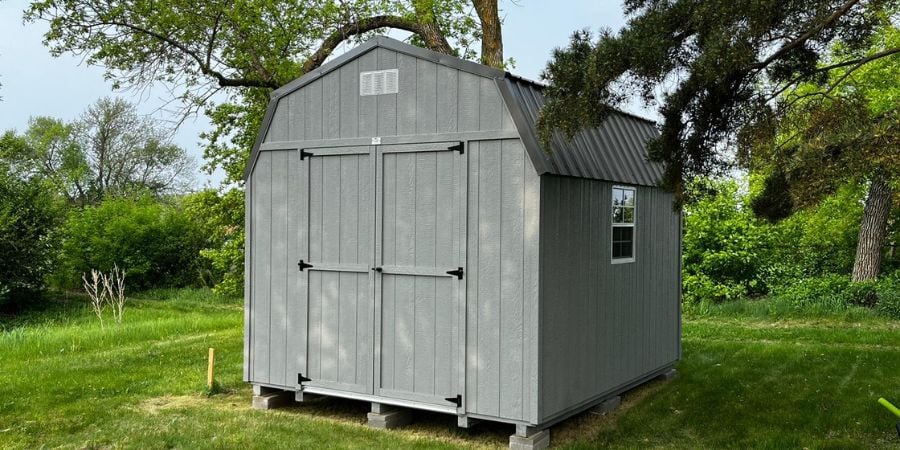
One of the biggest benefits of buying a shed pre-built is its convenience. With a prefab shed, there’s no heavy lifting or complicated assembly — just pick your shed, have it delivered, and start using it right away.
However, buyers should carefully check flooring materials (some prefab models use untreated wood that may not withstand long-term moisture exposure) and verify the quality of walls and roofing materials.
A well-made prefab sheds can last at least 20 years with minimal maintenance.
Pros:
- Ready for immediate use: fast delivery and quick installation save time.
- Professionally built: ensures a higher level of construction quality than DIY sheds.
- More affordable than custom sheds, making them a cost-effective storage solution.
- Minimal labor required: most prefab sheds arrive assembled or require only a few hours for installation.
Cons:
- Limited customization: sizes, colors, and layouts are predetermined, with fewer modification options.
- Lower-quality materials in some models: some prefab sheds use untreated flooring or thinner siding that may require reinforcement.
- Size limitations: larger custom sizes or unique layouts may not be available.
- Delivery constraints: some prefab sheds may not be deliverable to properties with narrow access roads or obstructions.
Buy a Custom Shed
On average, custom-built sheds range from $7,000 to $18,000, depending on the size, materials, and features. Unlike prefab or DIY sheds, custom sheds are designed from the ground up to fit the exact needs of the buyer.

Buyers who opt for a custom shed can select everything from siding materials and roofing styles to door and window placements. They can also integrate additional features like electrical wiring, loft spaces, insulation, and reinforced flooring, making them ideal for more than just storage — some buyers turn their custom sheds into workshops, home offices, or recreational spaces.
Custom sheds are either built on-site or delivered pre-assembled. If a shed is too large to transport or if the property has access restrictions, on-site assembly may be necessary. This requires more time and a higher cost but allows for greater design flexibility.
Pros:
- Fully customizable: size, materials, color, and layout can be tailored to match your home or property.
- Higher-quality materials: custom sheds are often built with treated wood, weather-resistant siding, and durable roofing, ensuring longevity.
- Designed for long-term durability: better insulation, reinforced flooring, and weatherproofing extend the lifespan of custom-built sheds.
- Perfect for specialized needs: ideal for those using sheds as workshops, offices, or backyard studios.
Cons:
- More expensive than prefab sheds, especially with add-ons like insulation or electrical wiring.
- Longer wait times: custom designs require more planning, ordering materials, and scheduling with builders.
- Requires more decision-making: while customization is a benefit, it can be overwhelming to choose materials, styles, and features.
Which Is Better to Buy: Custom-Built Sheds vs. Pre-Built Sheds?
If you decide to buy a shed online instead of building a kit or creating a DIY shed from scratch, you’ll need to decide between pre-built and custom. While both options can be good, there are key differences that are worth noting. Here are a few.

Pre-built Sheds
- Prefab sheds are often less expensive than custom sheds.
- Most people purchasing a prefab shed tend to buy 10’x12’ or 10’x14’. If you want a non-traditional size, pre-built shed options will be limited.
- Some prefab sheds have untreated wood flooring and joists, which often leads to premature deterioration. However, some do have treated flooring and quality construction. Be sure to ask questions so that you understand what you’re buying.
- Pre-built sheds can be delivered as-is or quickly erected, usually in a matter of hours.
- While they may not last as long as a custom shed, a well-made prefab shed can last as long as 20 years.
Custom Sheds
- Custom sheds tend to be more expensive than pre-built sheds.
- A custom shed is made to your unique specifications and is often built to a higher quality than other shed options.
- With custom-built sheds, you don’t have to worry about cut corners or untreated wood flooring and joists.
- Many custom sheds are built off-site and then moved to your property. If the shed is particularly large or if your property is hard to access, you may have to have it built on-site, which could increase the cost.
Avoiding Common Shed Purchasing Mistakes
Even with thorough research, some buyers make avoidable mistakes that can lead to extra costs, unnecessary repairs, or a shed that doesn’t fully meet their needs. Understanding these pitfalls ahead of time can save you money, time, and frustration.
5 Common Shed Buying Mistakes to Avoid
1. Skipping Warranty Details
Many buyers focus on price and design but forget to check warranty coverage. Not all sheds come with comprehensive protection, and some warranties may exclude critical issues like water damage, flooring rot, or structural failures.
Before purchasing, always ask:
- How long does the warranty last?
- Does it cover materials, installation, and potential repairs?
- Are there conditions that could void the warranty (e.g., improper installation, lack of maintenance)?
A strong warranty ensures your shed is a long-term investment rather than an unexpected expense.
2. Choosing Low-Cost Materials That Don’t Last
It’s tempting to go with the cheapest option, but low-cost materials often mean shorter lifespans and higher maintenance costs.
Common issues with budget materials include:
- Untreated wood that is vulnerable to moisture, rot, and pests.
- Thin metal siding that dents easily and lacks proper insulation.
- Inferior roofing materials that don’t hold up to extreme weather conditions.
Instead, look for weather-resistant siding (vinyl, treated wood, or metal), reinforced flooring, and durable roofing materials to extend the life of your shed.
3. Underestimating Space Needs
A shed should fit your current storage needs and allow for future expansion. Many buyers make the mistake of buying a shed that’s just big enough for their current items, only to realize they need more space within a year or two.

Before finalizing your purchase, consider:
- Will you need space for additional tools, outdoor furniture, or seasonal storage in the future?
- Do you plan on using the shed for more than storage (e.g., a workshop, garden shed, or home office)?
- Would built-in shelving, loft space, or wall-mounted storage help maximize interior space?
If in doubt, size up — a slightly larger shed now can save you the cost of upgrading later.
4. Forgetting Installation Costs
When determining how much does a shed cost, the price of the shed itself is just one part of the total cost. Some buyers overlook installation-related expenses, which can lead to unexpected surprises.
Before purchasing, make sure to account for:
- Site Preparation: Leveling the ground, adding a gravel or concrete base, or removing obstacles.
- Delivery Fees: Some manufacturers charge extra based on distance or difficulty of placement.
- Permits & Zoning: Check local building codes to avoid fines or delays.
Knowing these costs ahead of time ensures a smooth and stress-free shed installation.
5. Plan Ahead for a Hassle-Free Shed Purchase
By avoiding these common mistakes, you’ll ensure your shed meets your needs, lasts for years, and fits within your budget — without any hidden surprises.
Still weighing your options? Download our Shed Buying Workbook for expert insights, comparison tools, and a step-by-step buying checklist!
Where Can I Buy a Shed Near Me?
Whether you want to purchase a DIY shed kit, a pre-built shed, or a custom shed, a quick Google search will provide many options. You can easily find where to buy a shed online — like a shed kit from Wayfair.com, a pre-built shed from a local or chain home improvement store, or order a custom shed from a shed manufacturer in your area.
At Dakota Storage Buildings, we are proud to serve North Dakota, South Dakota, Minnesota, western Wisconsin, northeast Nebraska, and north-central Iowa. See display lot locations.
Why Choose Dakota Storage Buildings?
Buying a shed is a big decision, and at Dakota, we make sure you get a structure that’s built to last. Our sheds offer high-quality craftsmanship, customizable options, and seamless delivery, ensuring you get the perfect storage solution without the hassle.

Durability That Lasts
We use premium materials designed to withstand the elements, from reinforced flooring to weather-resistant siding and roofing. Unlike lower-quality sheds that require frequent repairs, a Dakota shed is built for long-term reliability with minimal maintenance.
Designed for Your Needs
Whether you need extra storage, a workspace, or a backyard retreat, our sheds can be tailored to fit your space and style. Choose from multiple sizes, colors, and add-ons like shelving, lofts, and reinforced doors to create a shed that works for you.
Stress-Free Delivery and Installation
Skip the complicated setup — our team ensures a smooth delivery and professional installation, so you can start using your shed right away. With in-stock and custom options available, you get fast service without sacrificing quality.
Customer Support You Can Count On
We’re here to help from start to finish. Whether you have questions about permits, placement, or customization, our team provides expert guidance to make the process simple and stress-free.
Flexible Financing Options
A durable, well-built shed is an investment, and we offer affordable financing solutions to fit your budget. With transparent pricing and no hidden fees, you can get the storage you need without the financial strain.
When Is the Best Time to Buy a Shed?

Shed prices and availability fluctuate throughout the year, so timing your purchase wisely can help you save money and avoid long wait times. If you’re planning ahead, knowing when demand is highest — and when discounts are most common — can make a big difference.
Shed Buying Trends in 2025
- Spring and Fall: These are peak seasons for shed purchases, as homeowners prepare for summer projects or winter storage. High demand means limited availability and longer wait times, so ordering early is key.
- Winter: If you’re looking for the best deals, winter is often the ideal time to buy. Many suppliers offer discounts and promotions to move inventory before the busy season begins.
Tips for Getting the Best Shed Deals
- Sign up for supplier newsletters to get access to exclusive discounts and early promotions.
- Visit display lots to inspect sheds in person and take advantage of any on-site deals.
- Compare financing options to find a payment plan that fits your budget without delaying your purchase.
- Plan ahead — ordering in the off-season ensures you’ll have your shed ready exactly when you need it, rather than waiting during peak months.
Your Guide to Finding the Perfect Shed for Your Needs
At this point, you know that buying a shed will solve your storage problem. Now it's time to figure out specifics, including what size to get, which siding options are easy to maintain, and — most importantly — how much does a shed cost based on your budget and needs.
Our Shed Buying Workbook is designed to help you with these details to make shed shopping easy and ensure you’re making a good investment that will meet your needs long term.
More helpful storage and shed-related articles.
About Dakota Storage Buildings
Life is demanding and full of choices. We’d love to make just one aspect of your life a little easier. That’s why it’s our mission to provide storage solutions you can trust, from sheds and garages to coops and kennels. Customize your storage building with our online 3-D configurator, explore our stock buildings, or find a display location near you. Our team is now serving North Dakota, South Dakota, Minnesota, western Wisconsin, northeast Nebraska, and north-central Iowa. Discover The Dakota Difference.



